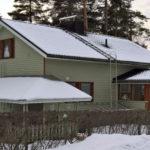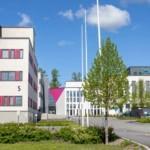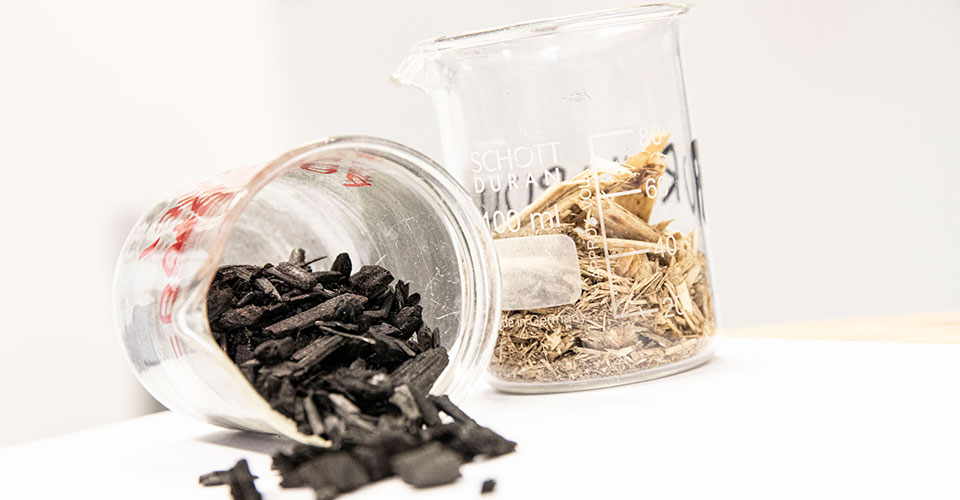
Daniel Kelly, Aaron Lehmus & Ari Lindgren
Biochar has many benefits such as soil water retention (Ayodele et al., 2009) but the production of it can be quite expensive. Is there a more efficient and cheaper way to produce this precious resource? HAMK Tech is on a mission to answer this question via the FiksuHiili (WiseCarbon) project.
The FiksuHiili Project which is being undertaken by HAMK Tech in collaboration with the HAMK Bio research unit, aims to provide a solution for producing biochar by using a modified boiler. Upon completion of the project, the goal is to have a cost-effective system that is fully or semi-autonomous, scalable, reproducible and can efficiently produce biochar in a continuous manner. The Veto 60 boiler (figure 1) is a traditional biomass boiler that operates on solid fuel biomass and can generate up to 60kW of power. It is suitable for heating single detached homes and small properties such as farms. (Ala-Talkkari, n.d.)
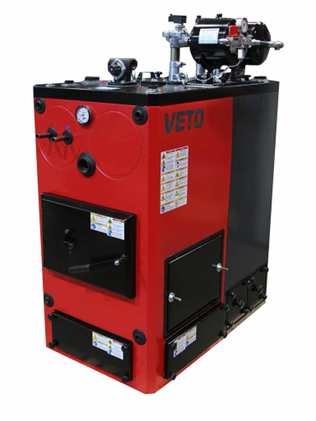
Biochar and Slow Pyrolysis
Biochar is a fine-grained and porous solid substance that resembles charcoal made by natural burning. It is produced by combusting biomass in an oxygen-limited environment (Sohi et al., 2009, p. 2). Slow pyrolysis is the thermal decomposition of biomass at low to medium temperatures such as 450 to 650 °C (Sohi et al., 2009, p. 7).
Modification of the boiler
To facilitate the production of biochar, modifications were made to the boiler such as the addition of the pyrolysis reactor, the biomass feeding system, the biochar removal system and the biochar cooling system. The reactor, illustrated in Figure 2, is the vessel inside which the process of pyrolysis will occur in the absence of oxygen. The reactor is made of acid-resistant stainless steel. When designing the reactor, a curved design was used due to the configuration of the boiler. The water body around the boiler restricted the use of a straight pipe.
There are three temperature measurement points inside the reactor and also the temperatures in the furnace and in the stack are measured. Temperature data is sent to the programmable logic controller, where decisions are made in the program based on predefined conditions regarding what action to perform next such as when the screw removes the char that has already been formed. In the middle part of the reactor, there is also an outlet for the forming pyrolysis gases. The reactor chamber can be seen in the figure below.
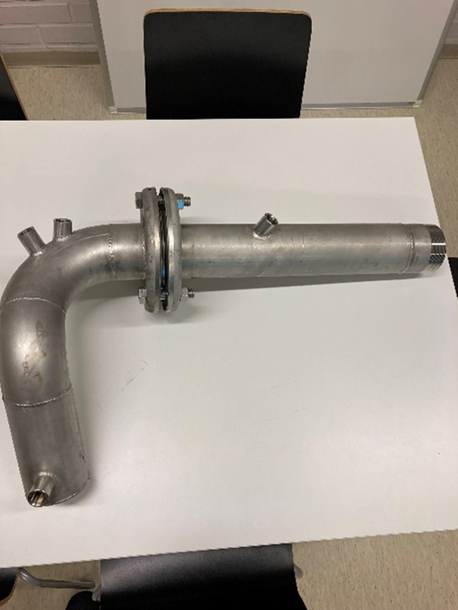
The feeding system (Figure 3) consists of a rotary feeder, which ensures the air tightness of the process and a screw conveyor, which transfers the biomass into the reactor. Since the temperature inside the furnace is more than 500 degrees, some amount of heat spread from the inside of the furnace to the feeding screw which resulted in the pre-drying of the biomass. The drying of biomass is an important step because it helps to ensure efficient biochar formation by removing excess moisture.
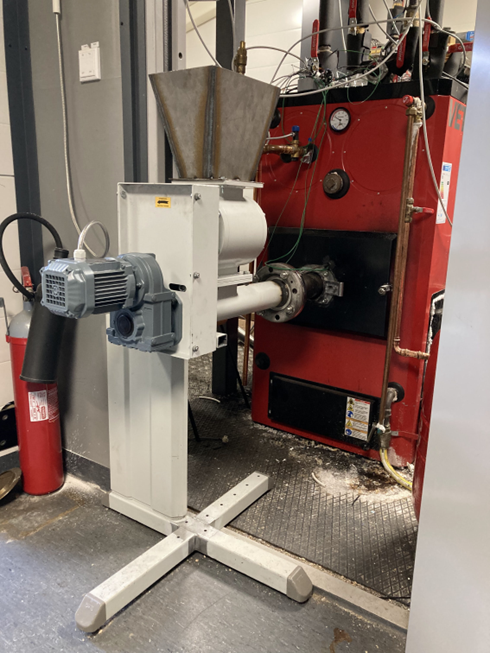
The biochar removal system, which is installed on the left side of the boiler, consists of a screw conveyor, two pneumatic knife gate valves and a vacuum pump. The motor of the screw is controlled by a programmable logic controller and a relay. The removal system is portrayed in Figure 4.
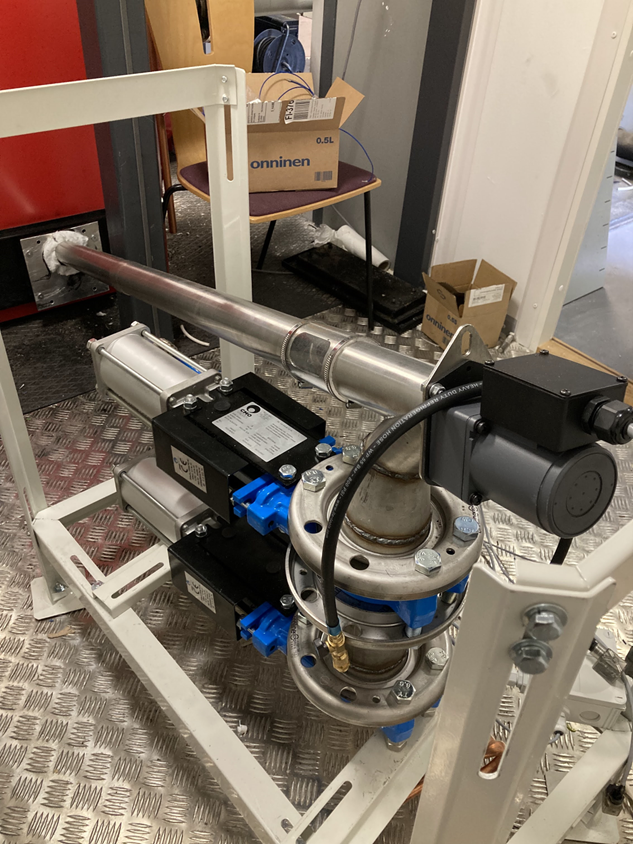
The biochar cooling system related to the removal system consists of a cooling coil, a circulation pump, a buffer tank and a heat pump. The circulation pump will circulate the incoming water through the cooling coil and back to the buffer tank. The buffer tank is cooled with an air-to-water heat pump. Also, there are plans for implementing a condensing system for the pyrolysis gases, which will be connected to the cooling cycle.
Hybrid module extension
The hybrid module had to be extended to facilitate the biochar removal system, the cooling system and the additional control cabinet. The width of the module was 3.4 meters before extension and then it was extended by 1.8 meters which makes the total width 5.2 meters. The length however was not extended and remained the same at 6.3 meters. The extension of the module is depicted in the figure below (Figure 5).
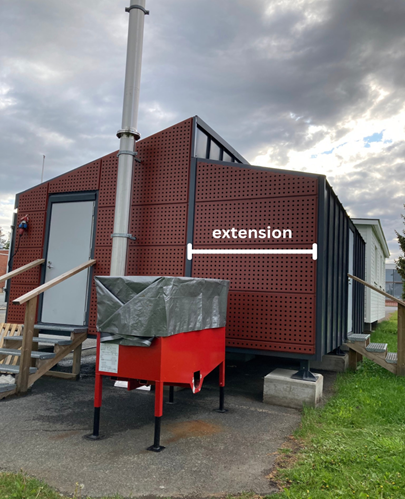
Burning Tests
In the subsequent paragraph, the results of one burning test will be briefly discussed. In total, twenty burning tests were conducted from November 9, 2022, to April 10, 2023. The average residence time was 1 hour and 39 minutes for all tests. The temperatures were measured from the locations mentioned before and also the weight and volume changes of the biomass were noted. Wood pellets were used as a heat source. The biomass used was mixed species of woodchips. The average mass reduction was around 60 %, while the average volume reduction was around 40 %. The temperature curves from the second test are displayed in the figure below (Figure 6).
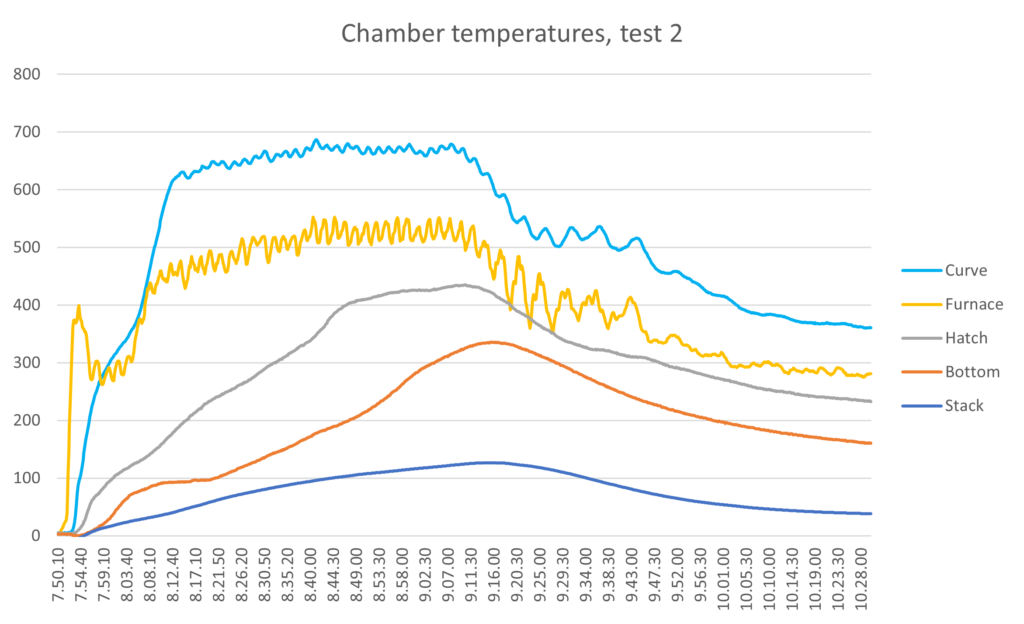
An important part of the pyrolysis process is the residence time. The residence time is the amount of time that the biomass has been inside the reactor (Solar et al., 2016, p. 43). The residence times can be greater than 5 seconds to produce syngas but ranges from minutes to days for biochar production (Sohi et al., 2009, p.7). Four tests were conducted with different residence times to figure out what was the required time for a good quality biochar. It was realized, that with this equipment, the quality was sufficient as soon as the temperature of the biomass reached 600 °C. This information is used to further optimize the control system.
Biochar analysis results
The biochar produced in the 7th and 8th pyrolysis tests were analyzed by HAMK Bio research unit to find out the quality of the char. The points of interest in these analyses were the carbon content and the H/C molar ratio and the O/C molar ratio. These are indicators of the stability of the biochar. In both of the tests, the carbon content was around 83 %, the H/C ratio around 0.4 and the O/C ratio 0.1. These results indicate good quality of biochar and are well within the limits of for example the European Biochar Certificate. Below is an image of the produced biochar (Figure 7).
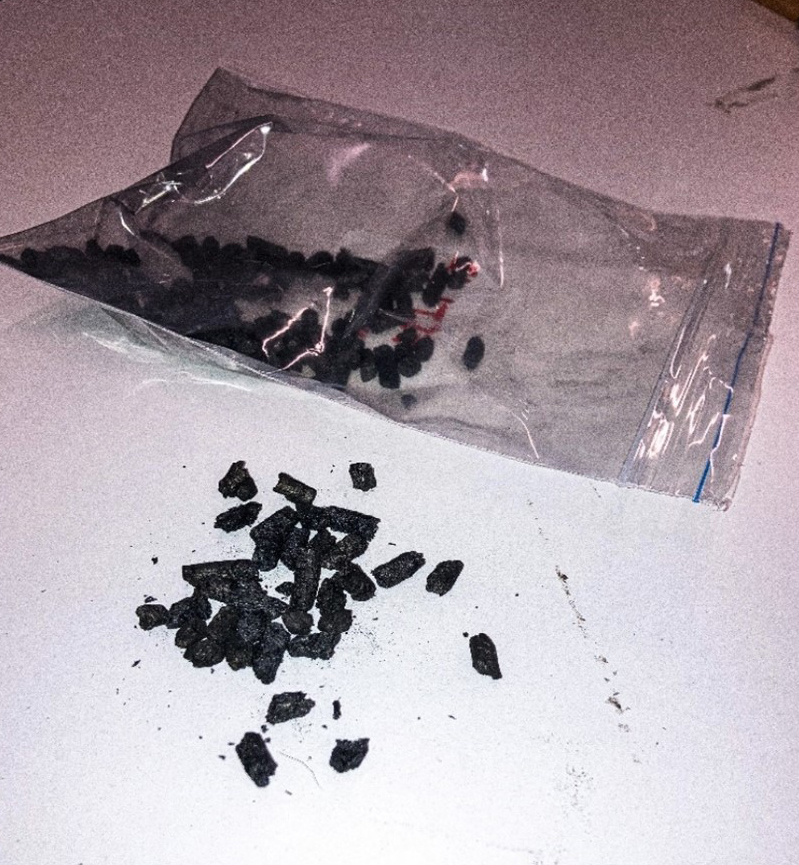
This article was written as part of the FiksuHiili project, which is funded by Pirkanmaan Liitto.

Tämä artikkeli korvaa 7.6.2023 julkaistun, poisvedetyn artikkelin (ks. liite).
This article replaces the retracted article, published on 7 June 2023 (see attachment).
Authors
Daniel Kelly, student assistant, electrical and automation degree, responsible for the control system.
Aaron Lehmus, project engineer, M.Sc. (Tech), designing and building the pyrolysis system and the cooling system.
Ari Lindgren, development engineer, M.A., responsible for the automation.
References
Ala-Talkkari. (n.d.). Lämmityskattila, Veto 60 kW-stokerikattila Ala-Talkkarilta. Veljekset Ala-Talkkari Oy. Retrieved February 2, 2023, from https://ala-talkkari.fi/lammityskattila-veto-60-stokerikattila/
Ayodele, A., Oguntunde, P., Joseph, A., & Dias Junior, M. de S. (2009). Numerical analysis of the impact of charcoal production on soil hydrological behavior, runoff response and erosion susceptibility. Revista Brasileira de Ciência Do Solo, 33(1), 137–146. https://doi.org/10.1590/s0100-06832009000100015
Solar, J., de Marco, I., Caballero, B. M., Lopez-Urionabarrenechea, A., Rodriguez, N., Agirre, I., & Adrados, A. (2016). Influence of temperature and residence time in the pyrolysis of woody biomass waste in a continuous screw reactor. Biomass and Bioenergy, 95, 416–423. https://doi.org/10.1016/j.biombioe.2016.07.004
Sohi, S., Lopez-Capel, E., Krull, E., & Bol, R. (2009). Biochar, climate change and soil: A review to guide future research. CSIRO.


